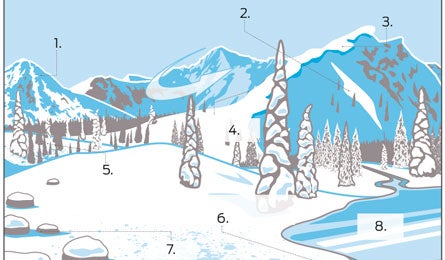Winter Survival Guide: Navigate

'Avalanche terrain hazards and safety (Supercorn)'
Plan Your Path
Learn to find the safest terrain and most efficient travel line with these pointers from SP Parker, professional mountain guide and owner of the Sierra Mountain Center’s mountaineering school.
- Avoid traveling on or below 30- to 45-degree slopes—prime avalanche terrain. Bring a slope index to convert map contour lines to a precise angle.
- Dense slabs and loose pillows of wind-deposited snow can build up on lee slopes. Slabs increase avalanche risk and pillows can make travel difficult.
- Cornices often break at a 45-degree angle, so you don’t need to be standing directly on one to be swept away by it. Also, avoid traveling beneath them.
- Windward ridges often have less snow, making them easier travel paths.
- Tree-covered areas on gentle angles are safer; the trees help anchor snowpack.
- Avoid traveling over ice near inlets and outlets where moving water prevents thick frozen layers from forming.
- Rocks absorb solar radiation, which makes nearby snow shallower than the surrounding snowpack—prone to postholing and an avalanche trigger.
- Solidly frozen lakes can be safe. Probe ice with a pole to ensure it’s at least two inches thick. Keep 100 feet between people.
Rise Before Shine
“If temperatures are hovering near or above freezing and you’re planning approaches on south- or east-facing slopes, consider starting predawn. There will be less potential for rockfall from thawing slopes above, and the snow surface will be more solid while it’s still frozen.”
–Andrew Matranga, BACKPACKER Map Editor
Listen Up
“Turn off your iPod and smartphone, since they interfere dangerously with avalanche beacon signals. Music or calls may also keep you from hearing the biggest sign of avy danger—a whumph sound made by a snowpack layer collapsing.”
–Jonathan Shefftz, National Ski Patrol avalanche instructor
Sidestep Snow Traps
“Especially on faster-paced descents, watch for signs of obstacles under the snow, such as a protruding branch or surface undulations from boulders. Your snowshoe could punch through a hollow spot, and you could twist a knee.”
–SP Parker